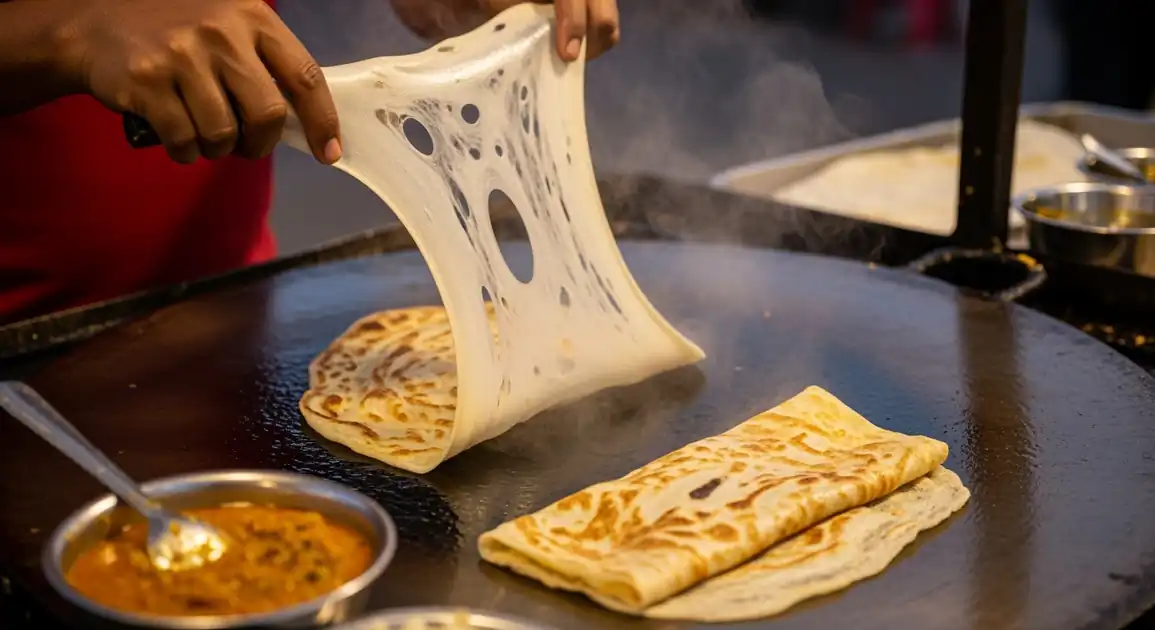Gothamba Roti (Sri Lankan Roti)
ගෝදම්බ රොටී

Description
Gothamba Roti is a cornerstone of Sri Lankan cuisine, found abundantly across the island. From bustling city street corners ('roti kade') to local eateries ('hotels'), it's a staple food enjoyed primarily in the evenings and nights, served plain with accompaniments or in various filled forms.
Dietary Information
Serving information
Serving style
Plain roti is usually folded into a square/rectangle and served on paper or a plate. Filled roti is often served folded. Eaten hot by hand, typically torn into pieces to scoop curries/sambols.
Quick facts
Mainly evening and night, typically from 4 PM or 5 PM until 11 PM or later.
Safety Tips
What to Look For
-
Roti cooked fresh to order
Ensures the roti is hot, cooked through, and hasn't been sitting out, reducing risk of contamination and ensuring best texture.
-
Vendor skillfully stretches dough thinly
Indicates experience and proper technique, often correlates with better quality and taste. Thin layers cook faster and more evenly.
-
Hot and clean griddle ('tawa')
A very hot surface ensures quick cooking and kills surface bacteria. It should be reasonably clean, free from excessive old burnt bits.
-
High customer turnover
Suggests the roti is popular and ingredients are likely fresh.
-
Hygienic handling of dough and fillings
Look for clean hands or utensils used for handling dough and adding fillings. Separate handling for raw/cooked items if applicable.
What to avoid
-
Pre-cooked roti sitting in a pile for a long time
Roti loses its texture and can become contaminated if left at room temperature.
-
Dirty griddle or preparation surfaces
Increases the risk of cross-contamination from old food residues or dirt.
-
Fillings (especially meat/egg) that look old or aren't cooked fresh
Risk of bacterial growth in fillings not kept properly hot or cooked thoroughly.
-
Visible cross-contamination between raw ingredients (if any) and cooked roti
Poor hygiene practices can transfer pathogens.
-
Vendors handling money and food without washing hands/changing gloves
Common source of contamination transfer.
Price information
Price range
Budget tips
- Plain Gothamba Roti is very cheap (30-60 LKR).
- Egg Roti typically costs 70-120 LKR.
- Filled roti (Veg, Fish, Chicken) usually ranges from 80-150 LKR.
- Prices are lowest at simple roadside stalls.
- Kottu Roti is a separate dish and costs more (300-800 LKR).
Value indicators
- Freshly made on a hot griddle.
- Good layering and thinness.
- Served hot and pliable.
- Generous filling for filled versions.
Where to Find This Dish
Near Bus Stands / Train Stations
High traffic areas with numerous food stalls, including Roti Kades.
Main transport hubs in towns
Evening, Night
Town Centers / Junctions
Busy intersections and main streets often have clusters of food stalls.
Clock towers, Main junctions
Evening, Night
Local Markets
Evening markets or areas around daytime markets often have roti stalls.
Weekly 'Pola' locations, Permanent market areas
Evening
Vendor Tips
- Look for the rhythmic clapping sound of Kottu Roti being made - these stalls always have Gothamba Roti.
- Don't be afraid to ask for it 'freshly made' ('aluthen hadala denavada?').
- Specify if you want egg ('biththara') or no egg ('biththara nethi').
How to Order
Regional Variations
-
Plain Gothamba Roti
(Gothamba Roti)
The basic, unfilled version, typically folded into a square or rectangle. Served with curries or sambols.
-
Egg Roti
(Biththara Roti (බිත්තර රොටී))
A popular variation where an egg (often mixed with onions and spices) is cracked onto the stretched dough before folding and cooking.
-
Vegetable Roti / Potato Roti
(Elavalu Roti / Ala Roti (එළවලු රොටී / අල රොටී))
Filled with a savory mixture of spiced vegetables, often predominantly potato.
-
Fish Roti
(Maalu Roti (මාළු රොටී))
Typically a triangular-shaped pastry made from Gothamba dough, filled with spicy fish (often canned mackerel/tuna mix), and usually deep-fried rather than griddle-cooked, but shares the dough base.
-
Chicken Roti
(Chicken Roti (චිකන් රොටී))
Filled with a spiced chicken mixture.
-
Kottu Roti
(Kottu Roti (කොත්තු රොටී))
A famous Sri Lankan street food dish made by chopping up Gothamba Roti on a griddle with vegetables, egg, meat, and spices.
Cultural context
History
Gothamba Roti has roots likely connected to South Indian layered flatbreads like Parotta, introduced through migration and trade. Over time, Sri Lanka developed its unique style, particularly the emphasis on extreme thinness during stretching and its integration into dishes like Kottu Roti. It's now deeply embedded in Sri Lankan culinary culture, available everywhere from humble street stalls to restaurants.
Local significance
A staple carbohydrate, versatile, affordable, and beloved across Sri Lanka. Essential component of the popular dish Kottu Roti.
Eating customs
- Eaten with the right hand.
- Torn into pieces for dipping.
- Considered informal street food.